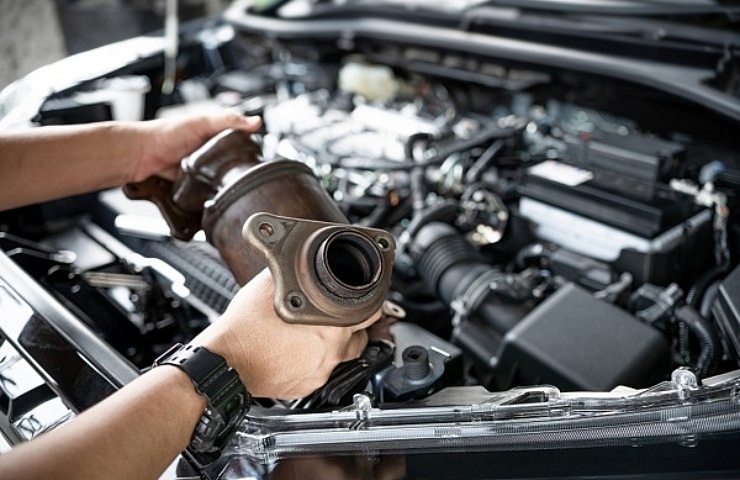European Car Models: Catalytic Converter Repair Guide
European car owners can find valuable information on catalytic converter repair for their specific car models in this guide. It covers common issues, repair techniques, and important considerations to keep in mind when dealing with catalytic converter issues, offering a comprehensive resource for resolving these problems effectively.
European car owners need to be well-informed about their car’s catalytic converter and how to address any issues that may arise. This guide provides an in-depth look at catalytic converter repair for various European car models, offering practical tips and insights to help keep these vehicles running smoothly.
Whether it’s a Mercedes-Benz, BMW, Audi, or Volkswagen, understanding the intricacies of catalytic converter repair is essential for maintaining optimal vehicle performance. By following the guidance in this comprehensive resource, European car owners can ensure their catalytic converters are functioning properly and avoid potential costly repairs down the road.
The Importance Of Catalytic Converters
Discover the significance of catalytic converters in European car models for effective emission control and environmental protection. Learn about essential catalytic converter repair guidelines to ensure optimal performance and compliance with regulations. Explore how proper maintenance of these components enhances your vehicle’s efficiency and reduces harmful exhaust pollutants.
Understanding the significance of catalytic converters is essential for car owners, especially those with European car models. These devices play a vital role in reducing harmful emissions from the exhaust system, making them a crucial component for environmental protection and compliance with emissions regulations.
Function And Significance
| Function | Significance |
|---|---|
| Absorbs harmful gases | Protects the environment |
| Converts pollutants into less harmful substances | Ensures compliance with emissions regulations |
| Promotes clean air | Improves overall air quality |
Catalytic converters function by absorbing harmful gases, such as carbon monoxide, nitrogen oxides, and hydrocarbons, produced during the combustion process inside the engine. These gases are then converted into less harmful substances like water vapor, carbon dioxide, and nitrogen. This conversion process is facilitated by the use of catalysts, typically made of precious metals, such as platinum, palladium, and rhodium.
The significance of catalytic converters cannot be overstated. By effectively reducing the emission of harmful pollutants, these devices help protect the environment and improve overall air quality. Additionally, catalytic converters ensure compliance with emissions regulations set by environmental agencies, making them indispensable for European car owners who must meet strict emissions standards.
Common Issues
Despite their importance, catalytic converters can experience various issues over time. Some common problems include:
- Blockage: Accumulation of carbon deposits or other contaminants can obstruct the flow of exhaust gases, reducing the converter’s efficiency.
- Physical Damage: Catalytic converters can be damaged by impact from road debris, speed bumps, or accidents, leading to reduced performance.
- Contamination: Use of improper fuel, such as leaded gasoline, or the presence of engine oil or coolant leaks can contaminate the catalyst, impairing its effectiveness.
- Mechanical Failure: Over time, the internal components of the catalytic converter can deteriorate, resulting in reduced efficiency or complete failure.
When these issues arise, it is crucial to address them promptly to maintain optimal performance and ensure compliance with emissions regulations.

Credit: www.thezebra.com
European Car Models With Catalytic Converters
European car models with catalytic converters represent some of the most prestigious and high-performance vehicles on the market. These models are known for their superior engineering and for embodying the perfect blend of luxury, power, and efficiency. However, like any other vehicles, European cars with catalytic converters require proper maintenance and occasional repairs.
Popular European Brands
When it comes to European car models, several brands stand out for their exceptional engineering and quality craftsmanship. These brands are renowned for their commitment to innovation and luxury, making them highly sought after among automotive enthusiasts.
Specific Models To Watch
Within the array of European car models with catalytic converters, certain specific models have gained widespread acclaim for their performance, aesthetics, and cutting-edge technology. These models are often celebrated for setting new standards in the automotive industry and delivering an unparalleled driving experience.
Diagnosing Catalytic Converter Problems
Diagnosing issues with your catalytic converter is essential to ensure your European car continues to run efficiently and smoothly. The catalytic converter plays a crucial role in reducing harmful emissions, and any problems with it can lead to decreased fuel efficiency and performance issues. Identifying symptoms and employing testing methods can help in early detection and resolution of catalytic converter problems, preventing further damage to your vehicle.
Symptoms To Look Out For
To accurately diagnose catalytic converter problems, it’s vital to be aware of the common symptoms that indicate malfunction. Look out for the following signs:
- Decreased engine performance and power
- Increased fuel consumption
- Rattling or vibrating noises from the exhaust system
- Illuminated check engine light
- Rotten egg smell from the exhaust
Testing Methods
Various testing methods are available to accurately diagnose catalytic converter problems. Consider utilizing the following techniques:
- Exhaust back pressure test – Measures the pressure in the exhaust system to identify any restrictions caused by a faulty catalytic converter.
- Temperature test – Utilizes an infrared thermometer to check for temperature differences before and after the catalytic converter, indicating its efficiency.
- Oxygen sensor test – Analyzes the oxygen sensor data to detect abnormal exhaust readings, signaling potential catalytic converter issues.

Credit: www.ebay.com
Catalytic Converter Repair Options
Learn about the various repair options for European car models’ catalytic converters with this comprehensive guide. Discover effective solutions to fix and maintain your catalytic converter, ensuring optimal performance and compliance with emission regulations.
Diy Vs. Professional Repair
Replacement Vs. Repairing
When it comes to catalytic converter repair options, there are a few factors to consider. Catalytic converters are vital components in European car models, helping to reduce harmful emissions and ensure compliance with environmental regulations. However, over time, they can become damaged or worn out, requiring repair or replacement. In this guide, we will explore two crucial aspects of catalytic converter repair options: DIY vs. Professional Repair and Replacement vs. Repairing.Diy Vs. Professional Repair
If you have some mechanical skills and the necessary tools, you might be tempted to take the DIY route when it comes to catalytic converter repair. DIY repairs can be a cost-effective option, saving you money on labor costs. However, it is important to consider your level of expertise and the complexity of the repair. Catalytic converter repair requires precision and knowledge, and an incorrect repair can lead to further damage or even safety hazards. Therefore, it is recommended to seek professional help if you are unsure about the repair process or lack experience in automotive repairs.Replacement Vs. Repairing
When facing catalytic converter issues, one question that arises is whether to opt for replacement or repairing. The decision depends on the extent of the damage and the cost-effectiveness of each option. If the catalytic converter is severely damaged or corroded, replacement may be the only viable option. However, for minor issues such as clogged or deteriorated substrates, repairing can be a more economical choice. It is best to consult with a professional mechanic who can assess the condition of your catalytic converter and provide guidance on the most suitable course of action. To summarize, when it comes to catalytic converter repair options, considering DIY vs. professional repair and replacement vs. repairing is crucial. While DIY may seem like a money-saving option, it is important to assess your skills and expertise before taking on the repair yourself. Similarly, choosing between replacement and repairing depends on the extent of the damage and the cost-effectiveness of each option. Seeking professional advice can help you make an informed decision and ensure the appropriate repair for your European car model.Maintaining A Healthy Catalytic Converter
Maintaining a healthy catalytic converter is crucial for European car models’ performance and emission control. Regular inspections, fixing any exhaust leaks, using high-quality fuel, and avoiding engine misfires can prolong the converter’s lifespan and ensure it functions optimally.
Maintaining a Healthy Catalytic Converter Numerous European car models come equipped with catalytic converters to reduce harmful emissions. Preventive maintenance tips can help extend its lifespan. Regular cleaning and care are crucial to ensure optimal performance.Preventive Maintenance Tips
– Check engine performance frequently to detect issues early. – Use high-quality fuel to prevent clogs and build-up. – Schedule regular inspections with a trusted mechanic. – Address any engine problems promptly to prevent damage.Cleaning And Care Guide
– Inspect the catalytic converter for damage or leaks routinely. – Avoid harsh chemicals that could harm the converter. – Clean the exterior gently to prevent corrosion. – Replace damaged or worn-out components as needed.
Credit: www.jdpower.com
Frequently Asked Questions Of European Car Models: Catalytic Converter Repair Guide
Do European Cars Use Catalytic Converters?
Yes, European cars use catalytic converters. These devices are essential for reducing harmful emissions and are a standard feature in European car manufacturing.
Can A Damaged Catalytic Converter Be Repaired?
A damaged catalytic converter cannot be repaired and needs to be replaced. Repairing is not possible due to the complex nature of the internal components. Replacement is the only solution to restore the converter’s proper functionality.
Can I Fix A Catalytic Converter Without Replacing It?
Yes, catalytic converters can sometimes be repaired by replacing the damaged or worn-out components.
What Are The 3 Most Leading Failures Of A Catalytic Converter?
Common catalytic converter failures include clogging from excessive buildup, damage from overheating, and failure due to internal or external impact.
Conclusion
To sum up, maintaining a properly functioning catalytic converter is crucial for European car owners. By understanding the signs of a faulty converter and following the repair guide mentioned above, you can ensure the longevity and efficiency of your vehicle.
Regular maintenance and timely repairs will not only reduce harmful emissions but also save you from costly repairs in the long run. So, take care of your catalytic converter and enjoy a smooth driving experience in your European car.

